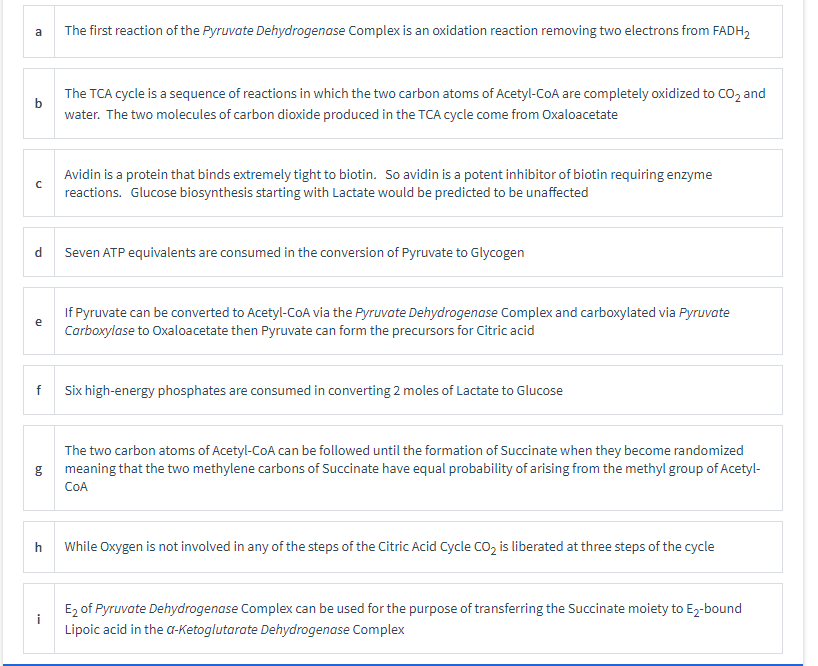a b с e f g h The first reaction of the Pyruvate Dehydrogenase Complex is an oxidation reaction removing two electrons from FADH₂ The TCA cycle is a sequence of reactions in which the two carbon atoms of Acetyl-CoA are completely oxidized to CO₂ and water. The two molecules of carbon dioxide produced in the TCA cycle come from Oxaloacetate Avidin is a protein that binds extremely tight to biotin. So avidin is a potent inhibitor of biotin requiring enzyme reactions. Glucose biosynthesis starting with Lactate would be predicted to be unaffected Seven ATP equivalents are consumed in the conversion of Pyruvate to Glycogen If Pyruvate can be converted to Acetyl-CoA via the Pyruvate Dehydrogenase Complex and carboxylated via Pyruvate Carboxylase to Oxaloacetate then Pyruvate can form the precursors for Citric acid Six high-energy phosphates are consumed in converting 2 moles of Lactate to Glucose The two carbon atoms of Acetyl-CoA can be followed until the formation of Succinate when they become randomized meaning that the two methylene carbons of Succinate have equal probability of arising from the methyl group of Acetyl- COA While Oxygen is not involved in any of the steps of the Citric Acid Cycle CO₂ is liberated at three steps of the cycle E₂ of Pyruvate Dehydrogenase Complex can be used for the purpose of transferring the Succinate moiety to E₂-bound Lipoic acid in the a-ketoglutarate Dehydrogenase Complex
a b с e f g h The first reaction of the Pyruvate Dehydrogenase Complex is an oxidation reaction removing two electrons from FADH₂ The TCA cycle is a sequence of reactions in which the two carbon atoms of Acetyl-CoA are completely oxidized to CO₂ and water. The two molecules of carbon dioxide produced in the TCA cycle come from Oxaloacetate Avidin is a protein that binds extremely tight to biotin. So avidin is a potent inhibitor of biotin requiring enzyme reactions. Glucose biosynthesis starting with Lactate would be predicted to be unaffected Seven ATP equivalents are consumed in the conversion of Pyruvate to Glycogen If Pyruvate can be converted to Acetyl-CoA via the Pyruvate Dehydrogenase Complex and carboxylated via Pyruvate Carboxylase to Oxaloacetate then Pyruvate can form the precursors for Citric acid Six high-energy phosphates are consumed in converting 2 moles of Lactate to Glucose The two carbon atoms of Acetyl-CoA can be followed until the formation of Succinate when they become randomized meaning that the two methylene carbons of Succinate have equal probability of arising from the methyl group of Acetyl- COA While Oxygen is not involved in any of the steps of the Citric Acid Cycle CO₂ is liberated at three steps of the cycle E₂ of Pyruvate Dehydrogenase Complex can be used for the purpose of transferring the Succinate moiety to E₂-bound Lipoic acid in the a-ketoglutarate Dehydrogenase Complex
Biochemistry
6th Edition
ISBN:9781305577206
Author:Reginald H. Garrett, Charles M. Grisham
Publisher:Reginald H. Garrett, Charles M. Grisham
Chapter20: Electron Transport And Oxidative Phosphorylation
Section: Chapter Questions
Problem 7P
Related questions
Question
which statements are False?

Transcribed Image Text:The first reaction of the Pyruvate Dehydrogenase Complex is an oxidation reaction removing two electrons from FADH2
a
The TCA cycle is a sequence of reactions in which the two carbon atoms of Acetyl-CoA are completely oxidized to CO, and
b
water. The two molecules of carbon dioxide produced in the TCA cycle come from Oxaloacetate
Avidin is a protein that binds extremely tight to biotin. So avidin is a potent inhibitor of biotin requiring enzyme
reactions. Glucose biosynthesis starting with Lactate would be predicted to be unaffected
Seven ATP equivalents are consumed in the conversion of Pyruvate to Glycogen
If Pyruvate can be converted to Acetyl-CoA via the Pyruvate Dehydrogenase Complex and carboxylated via Pyruvate
Carboxylase to Oxaloacetate then Pyruvate can form the precursors for Citric acid
f
Six high-energy phosphates are consumed in converting 2 moles of Lactate to Glucose
The two carbon atoms of Acetyl-CoA can be followed until the formation of Succinate when they become randomized
meaning that the two methylene carbons of Succinate have equal probability of arising from the methyl group of Acetyl-
COA
While Oxygen is not involved in any of the steps of the Citric Acid Cycle co, is liberated at three steps of the cycle
E2 of Pyruvate Dehydrogenase Complex can be used for the purpose of transferring the Succinate moiety to Ez-bound
i
Lipoic acid in the a-Ketoglutarate Dehydrogenase Complex
b0
Expert Solution
This question has been solved!
Explore an expertly crafted, step-by-step solution for a thorough understanding of key concepts.
This is a popular solution!
Trending now
This is a popular solution!
Step by step
Solved in 3 steps

Recommended textbooks for you

Biochemistry
Biochemistry
ISBN:
9781305577206
Author:
Reginald H. Garrett, Charles M. Grisham
Publisher:
Cengage Learning

Biochemistry
Biochemistry
ISBN:
9781305577206
Author:
Reginald H. Garrett, Charles M. Grisham
Publisher:
Cengage Learning